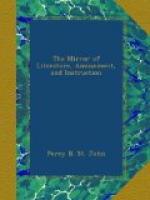Scenes of this description frequently give rise to marvellous stories; and Lydford Bridge has furnished many themes for the gossip’s tongue. It is related, that a London rider was benighted on this road, in a heavy storm, and, wishing to get to some place of shelter, spurred his horse forward with more than common speed. The tempest had been tremendous during the night; and in the morning the rider was informed that Lydford Bridge had been swept away with the current. He shuddered to reflect on his narrow escape; his horse having cleared the chasm by a great sudden leap in the middle of his course, though the occasion of his making it at the time was unknown.
Two or three persons have chosen this spot for self-destruction; and in a moment of desperation, have dashed themselves from the bridge into the murky chasm.
[1] Dartmoor appears the head-quarters
of dreariness and desolation,
forming
a mountain tract of nearly 80,000 acres in extent,
strewed
with granite boulders and fragments of rocks, and
appearing
to set cultivation at defiance.—Brande’s
Outline
of
Geology.
[2] John Britton and E.W.
Brayley: in the Beauties of England and
Wales,
vol. iv.
[3] A poet of considerable
eminence in his day, born at Tavistock,
in
the year 1590. He was noticed by Selden, Drayton,
Brooke,
Glanville,
and Ben Jonson.
[4] Warner’s Walk through the Western Counties.
* * * * *
Libels on Poets.—Cicero tells us, Democritus and Plato said that there could be no good poet without a tincture of madness; and Aristotle calls poets madmen.—P.T.W.
* * * * *




